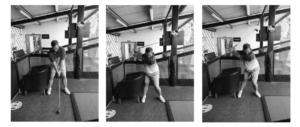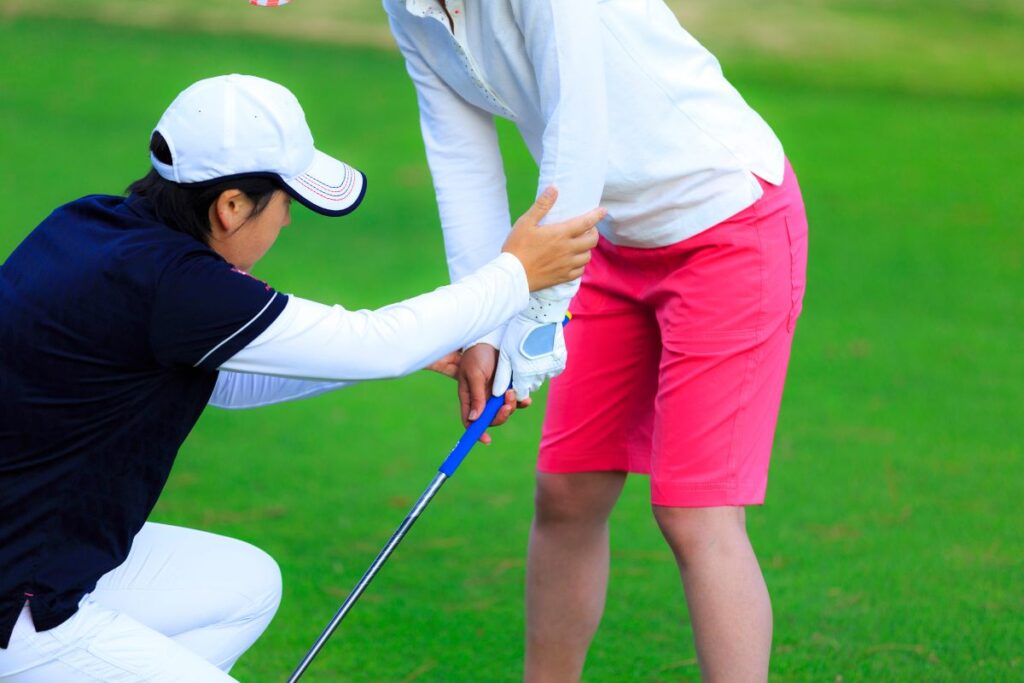Getting your golf swing just right is like finding the perfect rhythm in a dance. But sometimes, a tricky move called the “reverse pivot” can trip you up.
In this article, we’ll tackle this challenge head-on and show you simple steps to get your swing back on track and your golf game on point.
Table of Contents
What Is A Reverse Pivot?
A golfer doing a reverse pivot swing shifts their body weight the wrong way during their golf swing. When they swing back, their weight goes towards the front foot, and when they swing down, their weight goes towards the back foot.
This goes against the right way to distribute weight in a good golf swing. At the starting position, the weight should be equal between both feet. During the backswing, the weight should move to the back foot until the highest point of the swing. After that, the weight should move forward to the front foot during the downswing, and by the end, most of the weight should be on the front foot.
Issues Linked to a Reverse Pivot Golf Swing
1. Not Enough Power Transferred to the Ball
The golf ball can achieve its maximum height and energy to reach the target when the golfer effectively transfers the force built up during the swing into the ball upon impact.
However, this requires generating enough force initially, which occurs as the weight shifts from the back foot to the front foot at the moment of impact.
2. Results in hitting the ball upwards and making thin shots
If the golfer’s weight is mostly on the back foot when they hit the ball, the lowest part of their swing will be far behind the ball. This makes it more likely that they’ll hit the ball thin, which is not ideal.
How to Correct a Reverse Pivot
1. Don’t Attempt to Raise the Ball
Some golfers end up with a reverse pivot because they think they should help lift the ball from the ground. They try to scoop the ball from underneath, keeping their weight on the back foot and hands behind the ball.
However, this usually doesn’t work well because the ball is on the ground. You can’t really push it up from underneath. Instead, trust your golf clubs to provide enough lift to get the ball in the air.
To hit the ball well, swing down and make sure your hands are in front of the ball when you hit it. This will help the ball fly high and far.
2. Shift your weight to your back foot as you swing back
To correct a reverse pivot, begin with the takeaway and backswing. Concentrate on shifting your body weight to the back foot during these initial phases of the swing, preventing a reverse pivot from taking hold.
Once you’ve effectively shifted your weight backward, the next step is to smoothly transfer it forward as you continue into the downswing, leading to impact with the ball.
3. Ensure you complete the swing with your weight on the front foot.
With the takeaway issue resolved and the elimination of weight shifting toward the front foot during the backswing (as discussed above), the final step involves completing the weight transfer.
As you begin the downswing, focus on shifting your weight forward as you approach impact, aiming to have most of your weight on your front (left) foot.
A useful way to gauge your success is by observing how your weight is distributed between your feet during the follow through. If you can’t stand steadily using just your front foot at the end of the follow through, there might still be an issue to address.
Preventative Drills By Jon Woodroffe – World of Golf Master Professional

The fix involves getting the right hip movement, and this drill helps with that. Place your right hip next to a chair or table edge like in the picture. The chair should be heavy enough so it doesn’t move easily. Swing your golf club while keeping your right hip against the chair. If you move away from the chair, that’s the reverse pivot. If you push the chair, that’s swaying – and that’s not good.
Keep practicing this, and if you can, hit balls while doing it. Soon enough, you’ll get the hang of the right movement.
Types Of Reverse Pivot
The Three Types of Reverse Pivots:
- Takeaway Reverse Pivot – In this type, your hips and lower body move towards the target during the takeaway, causing your weight to shift onto your front foot. This often leads to rocking back onto your back foot as you approach the ball.
- Downswing Reverse Pivot – With this type, your hips and lower body move backward, causing you to fall back on your rear foot as you swing into the ball.
- Hip Slide / Upper Body Reverse Pivot – Here, your hips slide or sway away from the target, causing your upper body to lean back towards the target.
Remember, what happens inside affects the outside. Your core’s actions dictate the path of your arms and club. It’s crucial to keep your lower body stable and properly load your upper body behind the ball. Numerous swing issues stem from reverse pivoting and being off balance.
Before attributing swing problems to your plane, setup, or release, ensure your core is functioning as it should.
Among the three reverse pivot types, the third one—where the hips sway away from the target and the upper body leans back—is the most common and, in my opinion, the most damaging.
What Is The Reverse Spine Angle?
Leaning your upper body too far back or bending it too much to the left (for right-handed players) during the backswing is called a Reverse Spine Angle. This mistake messes up the right sequence to start the downswing because your lower body gets in a tough spot that makes it hard to begin the downswing properly. This problem is also a big reason why golfers often get lower back pain.
When your lower body can’t start the downswing or struggles to move properly, your upper body ends up controlling the swing. This can lead to issues with your swing path and limit how much power you generate. The Reverse Spine Angle also stresses your lower back by stopping your abdominal muscles from working well during the backswing and putting too much pressure on the right side of your spine when you hit the ball.
What Leads to Reverse Spine Angle and How to Identify It
To maintain your spine angle during the backswing, you need to work on a few important things. First, being able to turn your upper body separately from your lower body is crucial.
This helps your shoulders move around your spine without bending too far back or leaning too much to the side. Limited separation between your upper and lower body often happens when your spine doesn’t move well and your side muscles are too tight.
Next, if you’re a right-handed golfer, it’s really important that your right hip can rotate internally. This lets you rotate fully into your right hip without moving sideways.
If your hip can’t move well, you might end up swaying to the side. This can make your spine bend backward and cause a reverse spine angle.
Lastly, having a strong core – your abs and glutes – is really important for keeping your spine angle steady during the backswing. Your core muscles help keep your upper body bent forward in your golf swing.
Reverse Spine Angle can also happen if your pelvis tilts too much when you set up, causing your lower back to curve like an “S”. If your lower back doesn’t straighten out as you swing back, it can lead to the reverse spine angle problem.



